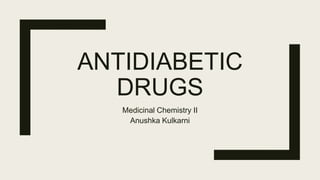
Anti diabetic drugs
- 2. Anti-diabetic medications treat diabetes mellitus by lowering glucose levels in the blood. With the exceptions of insulin, exenatide, and pramlintide, all are administered orally and are thus also called oral hypoglycaemic agents or oral antihyperglycemic agents. Diabetes mellitus type I is a disease caused by the lack of insulin. Insulin must be used in Type I, which must be injected. Diabetes mellitus type 2 is a disease of insulin resistance by cells. Treatments include: agents that increase the amount of insulin secreted by the pancreas, agents that increase the sensitivity of target organs to insulin, agents that decrease the rate at which glucose is absorbed from the gastrointestinal tract.
- 3. Classification : Enhance Insulin secretion – 1.Sulfonylureas - First generation: Tolbutamide Second generation: Chlorpropamide, Glipizide, Glimepiride. 2.Meglitinide analogues - Repaglinide, Nateglinide. 3. Glucagon-like peptide-1 (GLP-1) receptor agonists (Injectable drugs) - Exenatide, Liraglutide. 4. Dipeptidyl peptidase-4 (DPP-4) inhibitors - Sitagliptin, Vildagliptin. Overcome Insulin resistance 1. Biguanides – Metformin. 2. Thiazolidinediones (PPAR activator) – Pioglitazone. Miscellaneous antidiabetic drugs – 1. α-Glucosidase inhibitors - Acarbose, Miglitol, Voglibose. 2. Sodium-glucose cotransport-2 (SGLT-2) Inhibitor – Dapagliflozin.
- 5. Mechanism of Action - Sulfonylureas stimulate the release of insulin from βcells of the pancreas. These cells metabolize glucose in the mitochondria to produce ATP, which increases the intracellular ratio ADP/ATP. The ATP sensitive K+channel is an octameric heterocomplex consisting of two units of the binding site for both sulfonylurease and ATP, designated as the sulfonylurea receptor type I (SUR1). Sulfonylurea binds to SUR1 which increases the intracellular ratio ADP/ATP which results in the closure of ATP sensitive K channels, leading to rapid influx of Ca+. Increased intracellular Ca2+ causes an alteration in the cytoskeleton and stimulates translocation of insulin containing granules to the plasma membrane and the exocytotic release of insulin.
- 6. STRUCTURE ACTIVITY RELATIONSHIP The pharmacophore is divided into four parts – 1. Para amino group, 2. Aromatic ring, 3. Sulphonamide group and 4. N1 substitution. 1. Para amino group – The substituent on the benzene ring in Para position should be substituted. Substituents like methyl, acetyl, chloro, bromo, trifluromethyl and dithiomethyl enhance antihyperglycemic activity. Substitution should always be on Para position or else activity is lost. The substituent must be lipophilic.
- 7. 2. Aromatic ring - It is the minimal structural requirement for antibacterial action. It should always be Para substituted. Other substituents result in formation of inactive compound. 3. Sulphonamide group -- It is essential for antibacterial activity. The sulphur atom should be directly linked to the aromatic ring. Substitution of free sulphonic group(-SO3H) instead of sulphonamide destroys activity. Replacement by sulphinic acid (-SO2H) and acetylation at N4 retains activity. Active form is in ionized form and maximum action is obtained at pH 6.6 – 7.4. 4. N1 substitution – N should be primary or secondary. R2 should be substituted with H, aromatic ring or heterocyclic ring. Heterocyclic ring substitution leads to highly potent compound. Single benzene ring at N1 is toxic. Size of group attached to the N is crucial for action and should also impart lipophilicity to the compound. N-propyl and higher homologues are active but activity is lost when N-substituent contains more than 12 or more carbons.
- 8. Tolbutamide IUPAC Name - 1-butyl-3-(4-methylphenyl)sulfonylurea Trade Name - Orniase. Synthesis -
- 9. Tolbutamide lowers blood sugar by stimulating the pancreas to secrete insulin and helping the body use insulin efficiently. It is a first generation sulfonylurea antidiabetic agent. Metabolism – Metabolized in the liver principally via oxidation of the p-methyl group producing the carboxyl metabolite, 1- butyl-3-p-carboxyphenylsulfonylurea. Absorption – Readily absorbed following oral administration. Dosage – Initial - 1 to 2 g orally once a day or in divided doses through the day. -Adjust dose based on blood glucose response. Maintenance dose: 0.25 to 3 g orally once a day or in divided doses through the day. Maximum dose: 3 g per day. Half life – About 7 hours Side effects – 1. Hypoglycaemia (various symptoms caused by low blood sugar levels, e.g. loss of consciousness) 2. Weight gain 3. Rare cases of liver damage 4. Drug interactions (especially first-generation drugs): Increased hypoglycaemia with cimetidine, insulin, salicylates, and sulphonamides.
- 10. Title Chlorpropamide Glipizide Glimepiride Structure First Generation Second Generation Third Generation IUPAC Name 1-(4-chlorophenyl)sulfonyl- 3-propylurea N-[2-[4- (cyclohexylcarbamoylsulfamoyl) phenyl]ethyl]-5-methylpyrazine-2 carboxamide 4-ethyl-3-methyl-N-[2-[4-[(4- methylcyclohexyl)carbamoylsulfam oyl]phenyl]ethyl]-5-oxo-2H-pyrrole- 1-carboxamide Trade name Diabinese Glucotrol Amaryl Use for the treatment of non- insulin-dependent diabetes mellitus (NIDDM). used to control blood sugar levels in patients with type 2 diabetes mellitus. used for the management of type 2 diabetes mellitus (T2DM) to improve glycemic control. Metabolism Metabolized in liver metabolized in liver metabolized by CYP2C9 Pharmacokinetic s Has high risk of prolonged hypoglycemia because of its long half-life of 36hrs . Readily absorbed from GI. rapidly absorbed, has a very quick onset of action and a short half-life of 4hrs. very potent and has a longer duration of action. Completely absorbed after 1 hr of administration. Half life 1-2hrs.
- 11. Title Chlorpropamide Glipizide Glimepiride Side effects Nausea, loss of appetite, diarrhea, Vomiting and weight gain may occur low blood sugar, allergic reaction, digestive problems such as nausea, diarrhea, or constipation. low blood sugar (hypoglycemia), headache Nausea, dizziness, weakness ,unexplained weight gain
- 12. 2.BIGUANIDES
- 13. Metformin IUPAC Name - 3-(diaminomethylidene)-1,1-dimethylguanidine Metformin is a first line agent for the treatment of type 2 diabetes that can be used alone or in combination with sulfonylureas, thiazolidinediones, incretin- based drugs, sodium glucose cotransporter-2 inhibitors, or other hypoglycemic agents.
- 14. Mechanism of Action Activates AMP activated protein kinase (AMPA-PK) Reduces hepatic glucose production Lowers blood glucose level
- 15. Pharmacokinetics – Absorbed through GI tissue and by small intestine. Bioavailability – 50-60% Not metabolized by liver. Excreted via tubular excretion Half Life- 2-5hrs. Uses – Used in non insulin dependant type 2 DM Polycystic Ovary Syndrome Side effects – GI upset Acidic acidosis Impaired absorption of Vit. B12
- 16. THANK YOU!